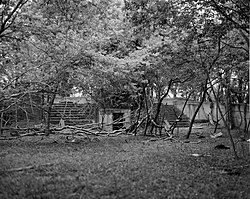Fort St. Philip | |
 Fort St. Philip in the U.S. Civil War | |
| Location | Plaquemines Parish, Louisiana, US |
|---|---|
| Nearest city | Triumph, Louisiana |
| Coordinates | 29°21′50″N 89°27′51″W / 29.36389°N 89.46417°W |
| Built | 1746 |
| NRHP reference No. | 66000380 |
| Significant dates | |
| Added to NRHP | October 15, 1966[1] |
| Designated NHL | December 19, 1960 |




Fort St. Philip is a historic masonry fort located on the eastern bank of the Mississippi River, about 40 miles (64 km) upriver from its mouth in Plaquemines Parish, Louisiana, just opposite Fort Jackson on the other side of the river. It formerly served as military protection of New Orleans, some 80 miles (130 km) up the river, and of the lower Mississippi River.
History[edit]
The first fort on this location, Fort San Felipe, was constructed in the 18th century during the period of Spanish control of Louisiana.
During the War of 1812 the garrison of Fort St. Philip defended the river approach to New Orleans. British naval forces attacked the fort on January 9 but were unsuccessful, withdrawing after ten days of bombardment.[2] Whilst the engagement appeared to have served no useful purpose to the British, it could be said it made a valuable contribution to the escape of Lambert's army elsewhere.[3][4] In a despatch sent to the Secretary of War, dated January 19, Jackson states 'I am strengthened not only by [the defeat of the British at New Orleans]... but by the failure of his fleet to pass fort St. Philip.'[5]
The current fort was constructed, along with Fort Jackson, as a coastal defense for New Orleans and the Mississippi, upon the urging of Andrew Jackson. It was the site of a twelve-day siege in April 1862 by Union forces during the American Civil War, which was the decisive battle in the capture of New Orleans.
It was declared a National Historic Landmark in 1960.[6]
In the 1930s the fort was used as a tanning factory. [citation needed]
During the Civil Rights Movement, Leander Perez threatened to jail opponents and demonstrators against segregation at the fort and in 1964 installed barbed wire.
From 1978 through 1989 the fort complex served as the site of an intentional, nonsectarian spiritual community called Vella-Ashby,[7][8] named by conjoining the surnames of the original and subsequent private property owners respectively. The community members numbered as many as 16 at any one time and were known as the Christos family. They lived in four buildings—three two-story officers quarters and an officers club—that remained from the re-fortification of the site during the 1898 Spanish–American War.[8]
Fort St. Philip remains privately owned and in a state of bad deterioration. It was heavily damaged in 2005 during Hurricanes Katrina and Rita. According to the National Park Service, the owner reported that only the original brick fort and the concrete structures from the time of the Spanish–American War remain.
The site is accessible only by boat or helicopter,[9] and following erosion of the small levee is now subject to flooding during high water levels of the Mississippi River.
See also[edit]
- National Register of Historic Places listings in Plaquemines Parish, Louisiana
- List of National Historic Landmarks in Louisiana
- Jackson Barracks, New Orleans
- Fort de la Balize
- Fort De La Boulaye
References[edit]
- ^ "National Register Information System". National Register of Historic Places. National Park Service. January 23, 2007.
- ^ Roosevelt (1900), p.237 ' At the same time [as the British Army's withdrawal from New Orleans], a squadron of vessels, which had been unsuccessfully bombarding Fort Saint Philip for a week or two, and had been finally driven off when the fort got [the ammunition for] a mortar large enough to reach them with, also returned; and the whole fleet [thereafter] set sail for Mobile.'
- ^ Reilly 1974, pp. 312–313.
- ^ Brown 1969, p. 160.
- ^ James 1818, pp. 459–460.
- ^ Patricia Heintzelman (1978). "National Register of Historic Places Inventory-Nomination: Fort St. Philip" (PDF). National Park Service.
{{cite journal}}: Cite journal requires|journal=(help)32 KB and Accompanying 6 photos, aerial photos from 1935 and others, undated. (3.09 MB) <--The PDF is the only part of this reference which is still a working link, November 2015. - ^ Sutton, James (2007-09-10). "Ft. St. Philip -- Vella-Ashby". Panoramio. Retrieved 2008-11-08.
- ^ a b Raber, Rick (1984-02-26). "The Christos Experiment". The Times-Picayune, Dixie supplement. New Orleans.
- ^ "Local attractions". Plaquemines Parish Tourism Commission. Retrieved December 12, 2021.
The site was heavily damaged by Hurricanes Katrina and Rita, and is now privately owned and only accessible by boat or helicopter.
- Brown, Wilburt S (1969). The Amphibious Campaign for West Florida and Louisiana, 1814–1815. Tuscaloosa: University of Alabama Press. ISBN 0-8173-5100-0.
- James, William (1818), A full and correct account of the military occurrences of the late war between Great Britain and the United States of America; with an appendix, and plates. Volume II, London: Printed for the author and distributed by Black et al., OCLC 2226903
- Latour, Arsène Lacarrière (1816), Historical Memoir of the War in West Florida and Louisiana in 1814–15, with an Atlas, Translated from French into English by H.P. Nugent, Philadelphia: John Conrad and Co, OCLC 40119875
- Reilly, Robin (1974), The British at the gates – the New Orleans campaign in the War of 1812, New York: Putnam, OCLC 839952
- Roosevelt, Theodore (1900). The Naval War of 1812. Vol. II. Annapolis: Naval Institute Press.
External links[edit]
- First Siege of Fort St. Philip (1815)—eyewitness accounts, as published in the Louisiana Historical Quarterly.
- Second Siege of Fort St. Philip (1862)—Chapter 15 of Kendall's History of New Orleans.
- Fort Saint Philip Budget Request at The Historic New Orleans Collection

